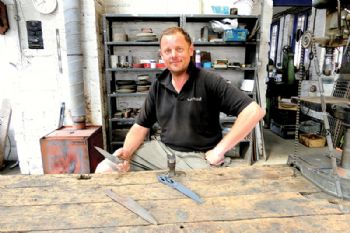
Now aged 48, Stuart Mitchell has been making chef’s knives for more than three decades, having ‘cut his teeth’ in the trade as a 10-year-old at his father’s knee.
His bespoke blades are made using many of the same tools his dad used before him (in the same red-brick workshop that his family took on in 1980); but despite being a traditional craftsman, Mr Mitchell’s curiosity about additive manufacturing made him consider if 3-D printing technology could be combined with his knife-making skills to create something both beautiful and unique.
His inquisitiveness led to a project with the Design and Prototyping Group (DPG) at the University of Sheffield Advanced Manufacturing Research Centre (AMRC —
www.amrc.co.uk) to produce a titanium chef’s knife that would not only demonstrate the technology but also allow him to compare the end product with his own hand-crafted knives.
The project is the subject of an exhibition called Digital Mesters: Advanced Manufacturing for 21st Century Knives, which was launched on 26 September at this year’s Festival of the Mind — the University’s collaborative festival showcasing pioneering science, art, engineering and culture across Sheffield.
Andy Bell, design strategy manager for the DPG, said: “This is design-led disruption in the truest sense of the word; a craft maker applying advanced manufacturing technologies and exploring how this could change his business model now and in the future.
"Design methods allow us to explore how we can approach problems like the introduction of additive manufacturing to people that would never normally approach this technology, due to the high perceived risk, cost and knowledge gap.
"However, we can use design to change perceptions by understanding the ways in which small businesses work, their needs and wants, and then develop a response to this in a risk-free way.
“We provided Stuart with an AM blank, whereas he would normally make one himself from sheet metal, grind it and sharpen it up. The difference with what we have made is integrating the blade and the handle, which was moulded and customised to a chef’s hand. We then delivered the printed knives to him for finishing.”
Engineers at the DPG used Autodesk’s Simulation Utility for Netfabb software to “aid their design and AM build optimisation work” for the additively manufactured knife and analyse the non-conventional support structure design — thanks to the software’s ability to simulate the influence of multiple parts on a build platform.
Project Engineer Luke Hill said: “The speed, ease of use and multi-part simulation ability of Simulation Utility for Netfabb quickly gave confidence that both knives to be printed during the build would benefit from reduced blade distortion, thanks to the novel support structure.”
Mr Mitchell, whose knives are used across the world in Michelin-star restaurants received the AM knife at the end of summer. He said: “I was impressed by the profile of the blade, and it replicated very well what I would do by hand — particularly the taper from the spine to the edge.
"It did need a degree of grinding to apply an actual cutting edge but the tolerances of the edge were good to start with. I didn’t realise a blade could be printed that fine.
“While I could achieve the curvature and the detail in the handle — and the hollowed out sections — it is not practical because there is probably a week or more’s worth of hand work there.
"However, technology means that material can be simply added or taken away by changes to a CAD model — and the knife made heavier or lighter as required.”